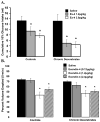Leptin and the systems neuroscience of meal size control
- PMID: 19836413
- PMCID: PMC2813996
- DOI: 10.1016/j.yfrne.2009.10.005
Leptin and the systems neuroscience of meal size control
Abstract
The development of effective pharmacotherapy for obesity will benefit from a more complete understanding of the neural pathways and the neurochemical signals whose actions result in the reduction of the size of meals. This review examines the neural control of meal size and the integration of two principal sources of that control--satiation signals arising from the gastrointestinal tract and CNS leptin signaling. Four types of integrations that are central to the control of meal size are described and each involves the neurons of the nucleus tractus solitarius (NTS) in the dorsal hindbrain. Data discussed show that NTS neurons integrate information arising from: (1) ascending GI-derived vagal afferent projections, (2) descending neuropeptidergic projections from leptin-activated arcuate and paraventricular nucleus neurons, (3) leptin signaling in NTS neurons themselves and (4) melanocortinergic projections from NTS and hypothalamic POMC neurons to NTS neurons and melanocortinergic modulation of vagal afferent nerve terminals that are presynaptic to NTS neurons.
2009 Elsevier Inc. All rights reserved.
Figures











Similar articles
-
The nucleus tractus solitarius: a portal for visceral afferent signal processing, energy status assessment and integration of their combined effects on food intake.Int J Obes (Lond). 2009 Apr;33 Suppl 1:S11-5. doi: 10.1038/ijo.2009.10. Int J Obes (Lond). 2009. PMID: 19363500 Review.
-
Leptin modulation of peripheral controls of meal size.Physiol Behav. 2006 Nov 30;89(4):511-6. doi: 10.1016/j.physbeh.2006.04.020. Epub 2006 Jun 2. Physiol Behav. 2006. PMID: 16735044 Review.
-
A potential role for hypothalamomedullary POMC projections in leptin-induced suppression of food intake.Am J Physiol Regul Integr Comp Physiol. 2010 Mar;298(3):R720-8. doi: 10.1152/ajpregu.00619.2009. Epub 2010 Jan 13. Am J Physiol Regul Integr Comp Physiol. 2010. PMID: 20071607 Free PMC article.
-
Modulation of vagal afferent excitation and reduction of food intake by leptin and cholecystokinin.Physiol Behav. 2006 Nov 30;89(4):477-85. doi: 10.1016/j.physbeh.2006.06.017. Epub 2006 Jul 26. Physiol Behav. 2006. PMID: 16872644 Review.
-
Leptin Sensitizes NTS Neurons to Vagal Input by Increasing Postsynaptic NMDA Receptor Currents.J Neurosci. 2020 Sep 9;40(37):7054-7064. doi: 10.1523/JNEUROSCI.1865-19.2020. Epub 2020 Aug 19. J Neurosci. 2020. PMID: 32817248 Free PMC article.
Cited by
-
Satiation and stress-induced hypophagia: examining the role of hindbrain neurons expressing prolactin-releasing Peptide or glucagon-like Peptide 1.Front Neurosci. 2013 Jan 21;6:199. doi: 10.3389/fnins.2012.00199. eCollection 2012. Front Neurosci. 2013. PMID: 23346044 Free PMC article.
-
Hindbrain neurons as an essential hub in the neuroanatomically distributed control of energy balance.Cell Metab. 2012 Sep 5;16(3):296-309. doi: 10.1016/j.cmet.2012.06.015. Epub 2012 Aug 16. Cell Metab. 2012. PMID: 22902836 Free PMC article. Review.
-
Loss of CTRP4 alters adiposity and food intake behaviors in obese mice.Am J Physiol Endocrinol Metab. 2020 Dec 1;319(6):E1084-E1100. doi: 10.1152/ajpendo.00448.2020. Epub 2020 Oct 5. Am J Physiol Endocrinol Metab. 2020. PMID: 33017221 Free PMC article.
-
NMDA-type glutamate receptors participate in reduction of food intake following hindbrain melanocortin receptor activation.Am J Physiol Regul Integr Comp Physiol. 2015 Jan 1;308(1):R1-9. doi: 10.1152/ajpregu.00388.2014. Epub 2014 Nov 12. Am J Physiol Regul Integr Comp Physiol. 2015. PMID: 25394828 Free PMC article.
-
Paraventricular nucleus-Medullary interactions: How they help enable endocrine responses to metabolic stress.Curr Opin Endocr Metab Res. 2022 Dec;27:100401. doi: 10.1016/j.coemr.2022.100401. Epub 2022 Aug 18. Curr Opin Endocr Metab Res. 2022. PMID: 39575062 Free PMC article.
References
-
- Rolls BJ, Drewnowski A, Ledikwe JH. Changing the energy density of the diet as a strategy for weight management. J Am Diet Assoc. 2005;105:S98–103. - PubMed
-
- Bjorntorp P. Thrifty genes and human obesity. Are we chasing ghosts? Lancet. 2001;358:1006–1008. - PubMed
-
- Hayes M, Chustek M, Heshka S, Wang Z, Pietrobelli A, Heymsfield SB. Low physical activity levels of modern Homo sapiens among free-ranging mammals. Int J Obes (Lond) 2005;29:151–156. - PubMed
-
- Leonard WR. Food for thought. Dietary change was a driving force in human evolution. Sci Am. 2002;287:106–115. - PubMed
-
- Leonard WR, Robertson ML. Nutritional requirements and human evolution: a bioenergetics model. Am J Hum Biol. 1992;4:179–195. - PubMed
Publication types
MeSH terms
Substances
Grants and funding
LinkOut - more resources
Full Text Sources
Miscellaneous

